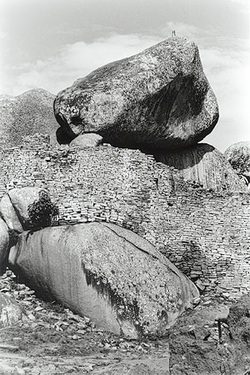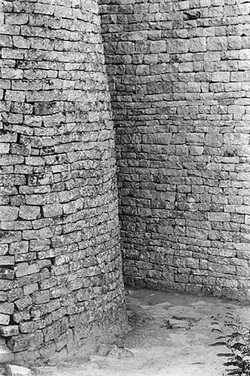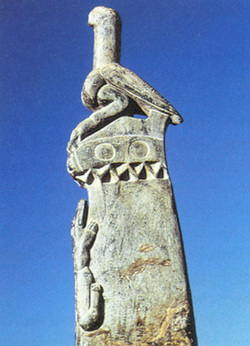Paragraph.
Stone Ruins

The ruins of this complex of massive stone walls undulate across almost 1,800 acres of present-day southeastern Zimbabwe. Begun during the eleventh centuryA.D.by Bantu-speaking ancestors of the Shona, Great Zimbabwe was constructed and expanded for more than 300 years in a local style that eschewed rectilinearity for flowing curves. Neither the first nor the last of some 300 similar complexes located on the Zimbabwean plateau, Great Zimbabwe is set apart by the terrific scale of its structure. Its most formidable edifice, commonly referred to as the Great Enclosure, has walls as high as 36 feet extending approximately 820 feet, making it the largest ancient structure south of the Sahara Desert.
In the 1800s, European travelers and English colonizers, stunned by Great Zimbabwe's its grandeur and cunning workmanship, attributed the architecture to foreign powers. Such attributions were dismissed when archaeological investigations conducted during the first decades of the twentieth century confirmed both the antiquity of the site and its African origins.
In the 1800s, European travelers and English colonizers, stunned by Great Zimbabwe's its grandeur and cunning workmanship, attributed the architecture to foreign powers. Such attributions were dismissed when archaeological investigations conducted during the first decades of the twentieth century confirmed both the antiquity of the site and its African origins.
Great Zimbabwe's Inhabitants

The enormous walls are the best-preserved testaments of Great Zimbabwe's past and the largest example of an architectural type seen in archaeological sites throughout the region. The function of these stone walls, however, has often been misinterpreted. At first glance, these massive nonsupportive walls appear purely defensive. But scholars doubt they ever served a martial purpose and have argued instead that cattle and people were valued above land, which was in any event too abundant to be hoarded.
The height of this wall is 11 meters. It is 6 meters thick at the base, 4 meters at the top and the circumference of this enclosure is 255 meters.
Source:Great Zimbabwe (11th–15th century) | Thematic Essay | Heilbrunn Timeline of Art History | The Metropolitan Museum of Art
The height of this wall is 11 meters. It is 6 meters thick at the base, 4 meters at the top and the circumference of this enclosure is 255 meters.
Source:Great Zimbabwe (11th–15th century) | Thematic Essay | Heilbrunn Timeline of Art History | The Metropolitan Museum of Art
Soapstone Birds

Great Zimbabwe's most famous work of art are the eight birds carved of soapstone that were found in its ruins.The birds surmount columns more than a yard tall and are themselves on average sixteen inches tall.
The birds are all about 33 cm in height and the overall columns (including the birds) are about 1.6 meters.
The birds are all about 33 cm in height and the overall columns (including the birds) are about 1.6 meters.
Title.

Paragraph.
